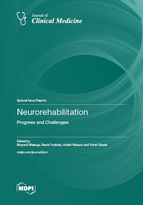Neurorehabilitation: Progress and Challenges
A special issue of Journal of Clinical Medicine (ISSN 2077-0383). This special issue belongs to the section "Clinical Neurology".
Deadline for manuscript submissions: closed (13 November 2023) | Viewed by 47755
Special Issue Editors
Interests: neurophysiology; neuroplasticity; electromyography; brain stimulation; neuromodulation; TMS; nerve stimulation; H-reflex
Interests: rehabilitation engineering; motor control; motion analysis; occupational therapy
Interests: neurorehabilitation; neural plasticity; electroencephalography; neuromodulation; neurofeedback; motor learning; motor control; stroke; aging
Special Issues, Collections and Topics in MDPI journals
Special Issue Information
Dear Colleagues,
Movement disorders caused by neurological diseases, such as stroke, Parkinson's disease, and degenerative spinocerebellar ataxia, can cause significant limitations in daily living. Neurorehabilitation is provided to reduce the burden associated with movement disorders, lessen the limitations in daily living activities, and enhance participation in the social sphere. To achieve progress in neurorehabilitation approaches, it is necessary to investigate the mechanisms of movement disorders, pathological hypotheses, and new intervention studies. For this Special Issue, we welcome research on a wide range of topics, including basic research that contributes to the elucidation of movement disorders, measurement technology to evaluate these disorders, new interventional research using neuromodulation techniques, and clinical research combining regenerative medicine and physiotherapy. We also welcome narrative analyses of single cases, systematic reviews, and meta-analyses regarding neurorehabilitation.
Dr. Akiyoshi Matsugi
Prof. Dr. Naoki Yoshida
Dr. Hideki Nakano
Dr. Yohei Okada
Guest Editors
Manuscript Submission Information
Manuscripts should be submitted online at www.mdpi.com by registering and logging in to this website. Once you are registered, click here to go to the submission form. Manuscripts can be submitted until the deadline. All submissions that pass pre-check are peer-reviewed. Accepted papers will be published continuously in the journal (as soon as accepted) and will be listed together on the special issue website. Research articles, review articles as well as short communications are invited. For planned papers, a title and short abstract (about 100 words) can be sent to the Editorial Office for announcement on this website.
Submitted manuscripts should not have been published previously, nor be under consideration for publication elsewhere (except conference proceedings papers). All manuscripts are thoroughly refereed through a single-blind peer-review process. A guide for authors and other relevant information for submission of manuscripts is available on the Instructions for Authors page. Journal of Clinical Medicine is an international peer-reviewed open access semimonthly journal published by MDPI.
Please visit the Instructions for Authors page before submitting a manuscript. The Article Processing Charge (APC) for publication in this open access journal is 2600 CHF (Swiss Francs). Submitted papers should be well formatted and use good English. Authors may use MDPI's English editing service prior to publication or during author revisions.
Keywords
- neurorehabilitation
- physiotherapy
- occupational therapy
- movement disorders
- stroke
- ataxia
- gait
- postural control
- neuromodulation
- assistive technology








